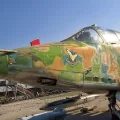
Sukhoi T-4 | |
|---|---|
| Country | Soviet Union |
| Role | Bomber – Reconnaissance |
| First flight | 22 August 1972 |
| Built | 4 |
The Sukhoi T-4, or “Aircraft 100”, or “Project 100”, or “Sotka” was a Soviet high-speed reconnaissance, anti-ship and strategic bomber aircraft that did not proceed beyond the prototype stage. It is sometimes called the Su-100.
Source: Sukhoi T-4 on Wikipedia
| Sukhoi 100/T-4-1 Walk Around | |
|---|---|
| Photographer | Sergey Zhabin |
| Localisation | Russian Air Force Museum |
| Photos | 36 |
Related kits:
Find kits on eBay:
See also:
The Sukhoi T-4 was a Soviet aircraft project that aimed to create a high-speed bomber and reconnaissance plane that could rival the American XB-70 Valkyrie. The T-4, also known as “Aircraft 100”, “Project 100” or “Sotka”, was designed by the Sukhoi bureau in the 1960s and 1970s, and required extensive research and development to overcome the technical challenges of sustained Mach 3 flight. The T-4 had a droop nose that could lower for better visibility during takeoff and landing, and a periscope for forward viewing when the nose was retracted. It also had four Kolesov RD-36-41 turbojet engines with afterburners, giving it a maximum speed of 3,200 km/h (2,000 mph) and a range of 6,000 km (3,700 mi). The T-4 could carry two air-to-surface missiles with a range of 1,500 km (930 mi) in its internal bay.
Only one T-4 prototype was completed and flew for the first time on 22 August 1972, piloted by Vladimir Ilyushin and Nikolai Alfyorov. The T-4 performed ten test flights until 19 January 1974, when the program was cancelled by the Ministry of Aviation Industry due to political and economic reasons. The T-4 was considered too expensive, complex and risky to produce in large numbers, and its role was taken over by other aircraft such as the Tupolev Tu-160. The only surviving T-4 is on display at the Central Air Force Museum in Monino near Moscow.
Views : 1957











